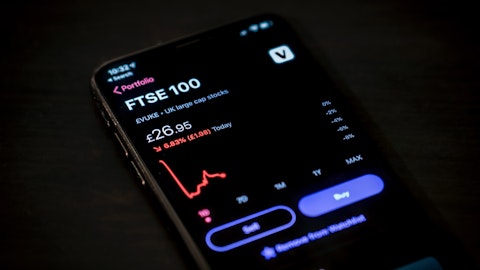Mark Adams: I’d say we’re not going to break out as you ask at that level, but we can give you the — the second part of your question more on the trends. I think it goes back to what we’re seeing as stable demand as far as we can see. But certainly, we’ve given — Ken has given guidance for Q2, and the kind of building of our funnel has been relatively stable. Again, my comment still holds from my earlier — from the earlier question that in these types of market conditions, it’s more around customer project management in terms of what they do in their budget process and do they push things out, do they move things in, what have you. We see continued investment across the commercial enterprises, and not breaking those out in any particular format.
And the government, which had been somewhat muted a little bit during the COVID — the highest point of COVID over the last couple of years, we think this year has been — will be positive in the first half, maybe in the Q3. But again, it’s really hard to see what’s going to happen, and so it has to do with really our customer environments and how they’re going to play their capital dollars and their investments.
Sidney Ho: Okay. That’s helpful. Maybe switching gears to the LED business. You talked about the business being impacted by headwinds in China and maybe in the U.S. and Europe as well. How do you expect the reopening of China going to impact that business positively, I guess? Will you start seeing the benefit in the February quarter or more in the May quarter? And if you can touch on the profitability of the business, what are you doing to contain costs, that would be great.
Mark Adams: Yes. Well, as we’ve talked about, we’re not calling the bottom to show up here in February quarter. We’ve kind of guided that — this is actually because of the holidays and Chinese New Year in the same quarter, given our fiscal quarters, we’re not seeing a bounce in this quarter. So, I would be muted a little bit in terms of our call on the bottom here in the quarter. We’d like — we think that with distribution burning a fair amount of inventory in Q1 and still in the Q2, and as you said, China is starting to open up a little bit, we could see some of that hopefully in our third quarter. And then, as far as the things we’re doing to manage our costs, headcount freeze, that type of thing, when we’ve looked at the type of support we have in our back-end facilities and maybe we’re optimizing around the number of lines we’re running and the schedules we’re running there, capital, looking at capital deployment and then how we can move that out in line with the market dynamics and just a number of things.
And it’s actually been a pretty meaningful number. But as you’ve highlighted and that people highlighted in the call, LED business has gotten hit very similarly to Brazil. So, we’re balancing out really good efforts on the cost containment with not trying to hurt the business for the long term because we do think it will bounce back at some point here.
Sidney Ho: Okay. Maybe one last one for me. Given the high interest rate, how should we think about interest expense going forward? And what portion of your debt is hedged at this point?
Ken Rizvi: Yes. So, this — I’ll answer that. If you look at our net interest expense in the formal script, we’d expect that to be at about $8 million. So, that’s both the interest expense and interest income on a cash basis, about $8 million, and that’s based on today’s SOFR rate. So, one of the things that we can’t predict is where those rates will go. But what we have been doing a good job is with the cash on hand, getting better and better interest income over time. But for now, I would assume it’s at that $8 million range of cash net interest expense per quarter, and that can fluctuate depending on what the Fed does. If you look at the kind of floating versus fixed on the debt, it’s about 70% floating and 30% fixed. The biggest piece of the fixed is that convertible note. That’s at a fixed rate of 2.25%. And then our TLA, which is about $570 in size, that’s at SOFR plus 2.25%.



